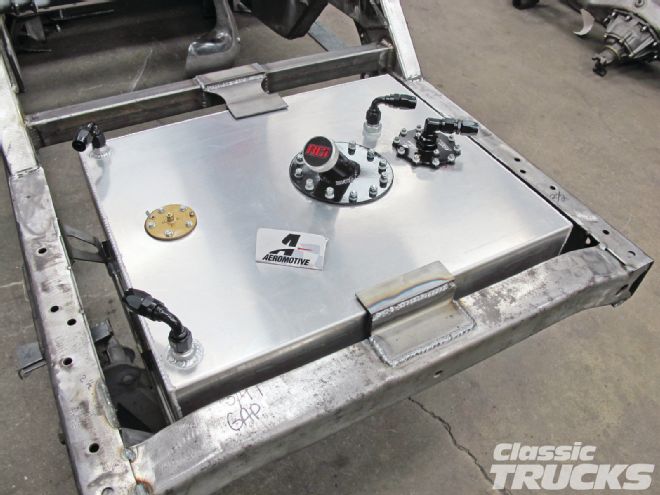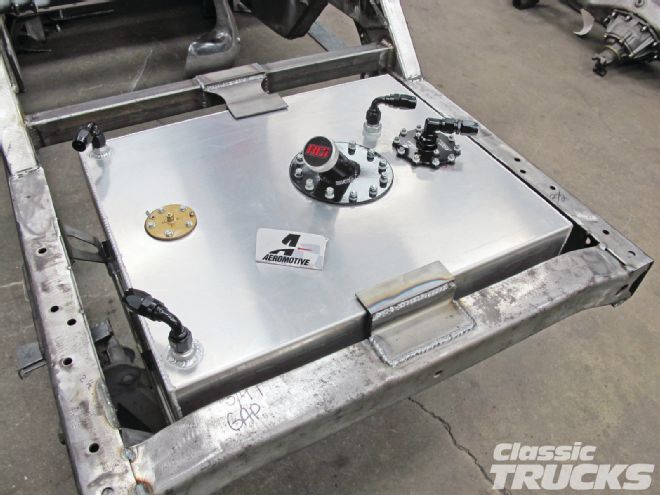
OK, so you made it into the 21st century with your powerplant, but you may be left in the dust because of your fuel delivery system. It’s common to see a new EFI system in classic trucks, all you have to do is go to a car show to see LS, mod, and EFI injected kits fitted inside old iron. What I have been noticing is a lack of attention to the fuel line, pump, and fitting department. This doesn’t mean that all installations looked bad, but rather the opposite, they were pretty good. I have seen a few that used sub-par, low-pressure hose to feed a 45psi EFI pressure line and were begging for problems—not that we would ever wish anyone’s hard work burn to the ground from a bad fuel line or hose end that was not fastened properly. This is why I would like to share with you some common practices that I have seen in race cars and street driven vehicles alike.

If burning your truck down to the ground doesn’t grab your attention, then how about losing precious horsepower from your power plant? Or worse, leaning your engine out? All of the aforementioned can happen from under sizing your fuel lines and thinking your motor doesn’t need that much fuel. Well, maybe it doesn’t, or does it? I have to ask you this: Do you plan on adding nitrous oxide, turbo, or a supercharger in the future? If so, why would you go with the bare minimum when it comes to the fuel line and fuel pump? Paying a little extra now to eliminate doing everything over again can save a lot of cash in the future. You may think that adding Boost or nitrous is the only reason to upgrade your fuel lines and fuel pump, but higher horsepower, naturally aspirated engines can and will take up more fuel than your truck’s stock 5⁄16-inch hard line. What I have done in the past is upgrade the stock fuel line from 5⁄16-inch to 3⁄8-inch, and in high horsepower engine applications used ½-inch line. The 3⁄8-inch hard line is equivalent to -06 AN hose and a ½-inch hard line is equivalent to -08 AN hose. Have you ever heard of gallons per hour? Gallons per hour is a measurement of how much fuel volume or flow can get through the fuel pump, fuel lines, filter, and fittings in one hour. For example, an A100 Aeromotive fuel pump is rated at 900 lb/hr but if the fuel lines and fitting were all 5⁄16-inch instead of 3⁄8-inch the rating would be significantly lower. Maybe this analogy will help, think about a garden hose that has a closed nozzle at the end of it. Inside the garden hose is 45 psi of water, now think about a fire hose with a much larger nozzle with the same 45 psi behind it. Now place two giant above-ground pools next to each other and see which fills up faster with water when the nozzles are open. Of course, the fire hose wins and it is not because of the 45 psi but because of the vast amount of volume that the larger hose could deliver.
Now that we scratched the surface of fuel pressure and volume, let’s talk about supplying the fuel pump with power and ground. Power and ground play a huge roll in how many gallons per hour the fuel pump will deliver. Lets say you are on a budget and your buddy has some 18g speaker wire laying around so you use it to connect your fuel pump power and ground. The pump would likely run but maybe not for long, not because the battery voltage was not there, but because the current or amperage to supply the full power to the pump was restricted. Aeromotive has a graph on the A1000 fuel pump showing the available pounds per hour via pressure and, more important, voltage. Aeromotive’s Graph shows a pressure of 45 psi at 12 volts, the pounds per hour is 700 but at the same pressure of 45psi with 13.5 volts, the pump is able to produce 800 lb/hr of fuel. The graph makes me think that the wire size and voltage are very important, and so is a good battery plus charging system. Aeromotive recommends the use of a 30amp relay with 16-18g wire feeding the relay, a 10g wire power wire to the pump, and a 10g ground connected to a clean chassis ground.